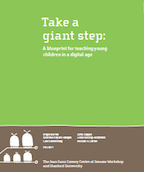On December 10, 2014, President Obama hosted the White House Summit on Early Education. Michael Levine was invited to participate in a panel on Equity and Excellence in the Earliest Years hosted by Megan Smith, Chief Technology Officer of the United States and Shannon Rudisill, Director of the Office of Child Care. The following are his remarks:
 Good afternoon colleagues, I’m Michael Levine and I run the Joan Ganz Cooney Center at Sesame Workshop. The Workshop—now over four decades old is perhaps the world’s best known educational media organization, reaching about 150 million children in 150 countries. Its mission is—most of you know—devoted to driving innovation in early learning with media and technology. Recent research, including work that the Center and our colleagues at New America have underway, is demonstrating that there is great untapped potential in properly deploying new technologies to modernize early leaning programs. Unfortunately to date, we—as a field—have been a little bit stuck. Worried about the distractions provided by a ubiquitous media culture in which too many children already do not get the adult nurturing and powerful supports they need, many in our field worry that educators and parents are living in something like the digital wild west. Can we help them navigate better? My view is: Yes, we can. But what do you think? Let me provoke this discussion by teeing up four critical issues for building a digital age architecture for America’s young children. I’ll finish with a challenge for our group.
Good afternoon colleagues, I’m Michael Levine and I run the Joan Ganz Cooney Center at Sesame Workshop. The Workshop—now over four decades old is perhaps the world’s best known educational media organization, reaching about 150 million children in 150 countries. Its mission is—most of you know—devoted to driving innovation in early learning with media and technology. Recent research, including work that the Center and our colleagues at New America have underway, is demonstrating that there is great untapped potential in properly deploying new technologies to modernize early leaning programs. Unfortunately to date, we—as a field—have been a little bit stuck. Worried about the distractions provided by a ubiquitous media culture in which too many children already do not get the adult nurturing and powerful supports they need, many in our field worry that educators and parents are living in something like the digital wild west. Can we help them navigate better? My view is: Yes, we can. But what do you think? Let me provoke this discussion by teeing up four critical issues for building a digital age architecture for America’s young children. I’ll finish with a challenge for our group.
Issue 1: Building infrastructure/Teacher prep—The early learning field is woefully unprepared to ‘modernize’ our practices. A recent task force that I co-chaired with Linda Darling-Hammond at Stanford studied the physical and human infrastructure for technology access and examined the workforce professional support needs of our early educators. We found that too few early learning centers have adequate broadband access, most teachers have never been exposed to new modes of integrating technology into their classrooms, and the lack of tech-enabled linkages to connect home and school is an opportunity lost.
Issue 2: Modern expectations for success—While as a field we know quite a bit about the components of a high quality early learning program, we haven’t yet defined a balanced set of expectations for young children who are growing up in a networked, global community. So we need to decide: what should a digitally competent 8-year-old know and be able to do?
Issue 3: Equity— Research from Susan Neuman and others indicates that there is a disturbing new equity gap evolving between low-income children and their more advantaged peers on technological fluency. As we better define expectations for every young child in a digital age, how will these expectations drive investments in equity? Are we in danger of setting the bar too low—focusing on closing word gaps, but missing the full potential of every child?
Issue 4: Innovation—My view: the field needs a whole new think about innovation—our signature programs resemble the generation of initiatives that were invented around the time that SS and Head Start debuted in 1969, and they may not be meeting the realities and needs of today’s families. Can tech be a driver for new designs—especially for the increasingly diverse families we are serving today?
So my provocation is we must reframe two digital age “E’s”: our expectations and commitment to equity and two “I’s: attend to our physical and human infrastructure, and drive a new innovation vision.
Here’s my challenge: We have heard the President and his cabinet announce exciting new programs today that are timely and sorely needed. But none directly focused on leveraging the potential of technology as a potential game changer! So I close with two questions: 1) how can we integrate what we know about the effective uses of tech to help drive the partnerships announced today and other innovative solutions to scale with a kind of multiplier effect; and 2) starting right now, how can we promote the next generation of technological innovations that the President, Congress, the states, practitioners and the private sector will embrace as worthy of new investments—hopefully in the near future?
I look forward to our discussion.

